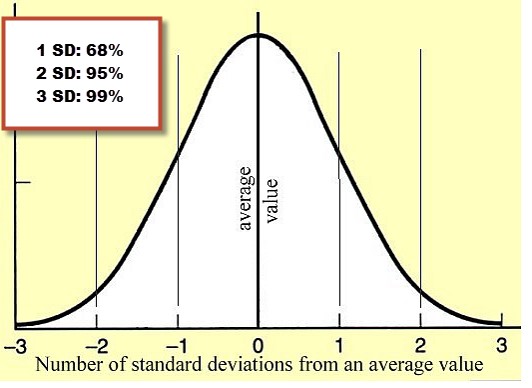Understanding the concept of implied volatility is essential for successful covered call writing and selling puts. First, implied volatility gives us a window into the “market’s” perception of future price movement. It will also allow us to calculate probability of a stock price reaching a certain level. Like all other parameters, implied volatility, although quite important and useful, does have its limitations. Let’s first compare the two major types of volatility:
Historical vs. implied volatility
Historical volatility is the actual price fluctuation as observed over a specific time frame. More specifically, it is the annualized standard deviation (discussed below) of past stock price movements.
Implied volatility is a forecast or market opinion of the underlying security’s volatility as implied by the option’s prices in the current market.
For short-term option sellers like us, current information is much more important than historical data which may be more appropriate for longer-term investors.
Implied volatility and our option premiums
We know that the time value component of our option premiums are impacted by time to expiration and the implied volatility of the underlying security. Since most of us ell 1-month or 1-week options, time to expiration will remain constant when comparing premiums. That leaves the implied volatility as the main factor influencing premium (remember we are talking time value, not intrinsic value). The good news is that the greater the implied volatility, the more premium our option sales will generate. The bad news is that we are incurring more risk to the downside as calculated by using the implied volatility stat. Understanding implied volatility will allow us to make informed decisions as we compare premium to implied risk.
How is implied volatility calculated?
To calculate implied volatility, we need (or someone needs…) an option pricing model like the Black-Scholes Option Pricing Model. Of these six inputs below, implied volatility is the only one not directly observable in the market and therefore we need the other five inputs to calculate implied volatility:
- Call premium
- Exercise price
- Price of underlying
- Risk-free interest rate
- Time to expiration
- Implied volatility
Standard deviation and implied volatility
The implied volatility generated from an option pricing model will tell us the probability of a certain price movement in either direction on an annualized basis. Let’s say a stock is trading at $30 and has an implied volatility of 20% for the at-the-money strike. This means that the share price, based on current option pricing, is expected to move up or down by $6 during the next year. In other words, the anticipated trading range is $24 to $36. This stat is for 1 standard deviation as it relates to a bell curve distribution of potential prices. Stated differently, we would expect a trading range of $24 to $36 68% of the time. Now, 2 standard deviations would be $12 in either direction or a range of $18 to $42 and is expected to stay in that range 95% of the time. 3 standard deviations would represent a range of $12 to $48 and would be expected to stay in that range 99% of the time. Still with me? Here’s what that distribution curve looks like:

Standard deviation: normal bell curve
Calculations for 1 month and 1 standard deviation
Since very few of us trade 1-year options, these implied volatility stats must be customized to our shorter-term periods. It’s not necessary to remember this math but you’re getting it anyway…
For a 30-day option and 1 standard deviation, we multiply the implied volatility stat by the square root of 30/365:
$30 x 20% x .286 = $1.72
This means that based on current option pricing, we would expect this stock to trade between $28.28 and $31.72 68% of the time during the next 30 days (I’m beginning to give myself a headache!).
Summary
Implied volatility is more important to short-term option sellers than is historical volatility. It demonstrates market sentiment about future price movement although does not define direction. We can use it to determine price probability and therefore risk parameters that will allow us to decide if a trade is consistent with our personal risk-tolerance and monthly goals. A quick, user-friendly way to estimate implied volatility is to look at the returns on an option. For example, if a 1-month at-the-money strike generates more than 6%, we are dealing with a high-implied volatility trade. This may be appropriate for some but not for others.
Market tone
The Federal Reserve’s mid-week commentary that the US economy was expanding at a solid pace and generating strong job growth generated market concern that interest rates may be raised sooner than anticipated. Lower interest rates are favorable for the stock market. There was also concern of declining oil prices which picked up on Friday resulting in a late-day selloff. This shows how unpredictable our markets can be. This week’s mixed reports:
- According to the Commerce Department, gross domestic product (GDP) in the 4th quarter declined to 2.6%, below the 3.1% projected by analysts
- For the year 2014 our economy expanded by 2.5%, above the recent trend of 2%
- Durable goods orders fell by7 3.4% in December as analysts were expecting a rise of 0.5%. This was the 4th decline in 5 months
- New home sales in December rose to an impressive annual rate of 481,000, well above the 450,000 anticipated
- Year-over-year new home sales rose by 8.8%
- The median price for new homes sold in December rose from $291,600 (in November) to $298,100. This represented an increase of $22,600 year-over-year
- The Conference Board’s Consumer Confidence Index in January increased to an impressive 102.9 well above the 95.0 expected. This represents the highest level since August, 2007
For the week, the S&P 500 fell by 2.8%.
Summary
IBD: Uptrend under pressure
GMI: 3/6- Buy signal since market close of January 23, 2015
BCI: Cautiously bullish but favoring in-the-money strikes 2-to-1 for new positions as a hedge against recent market volatility
Wishing you the best in investing,
